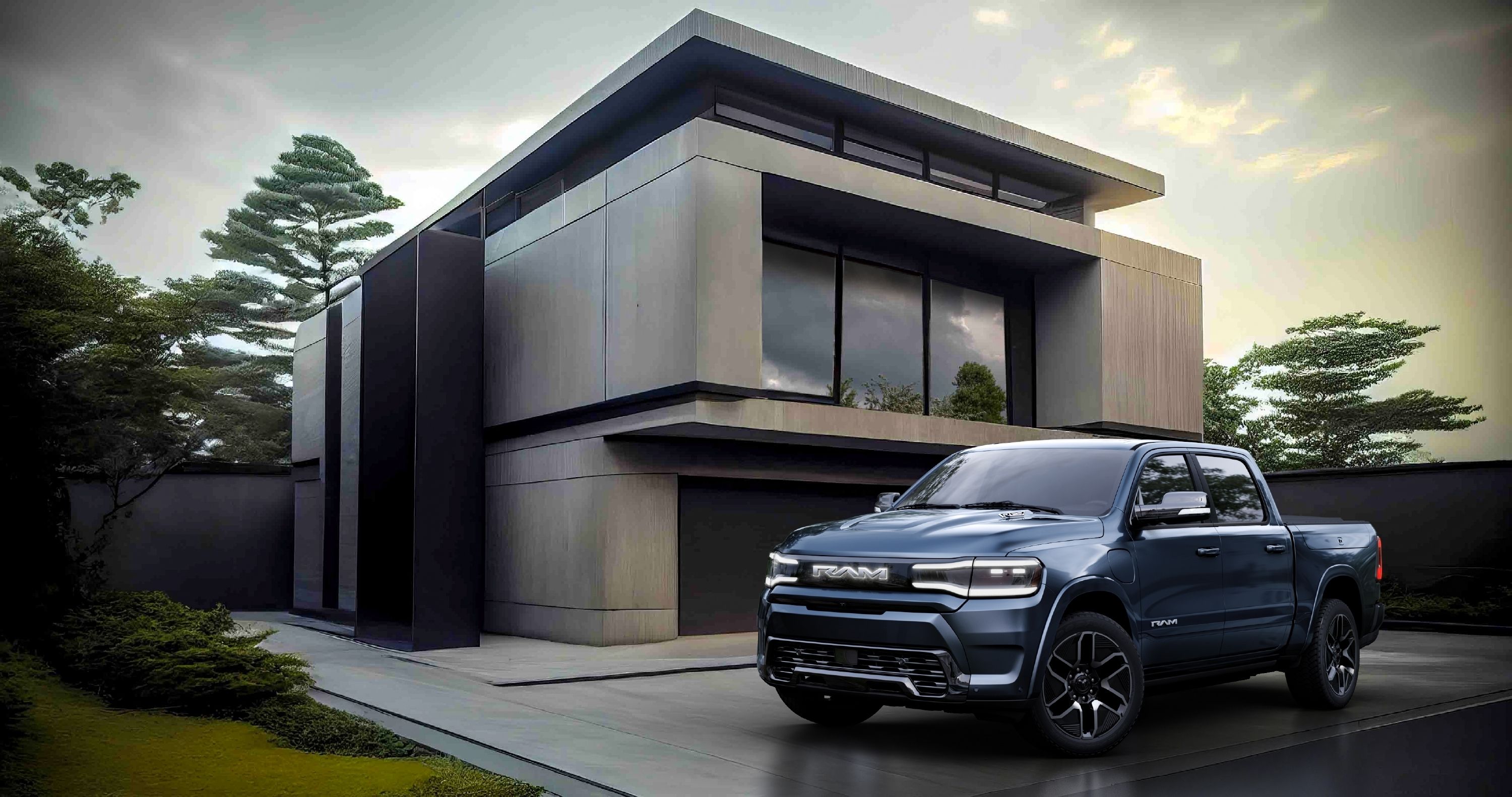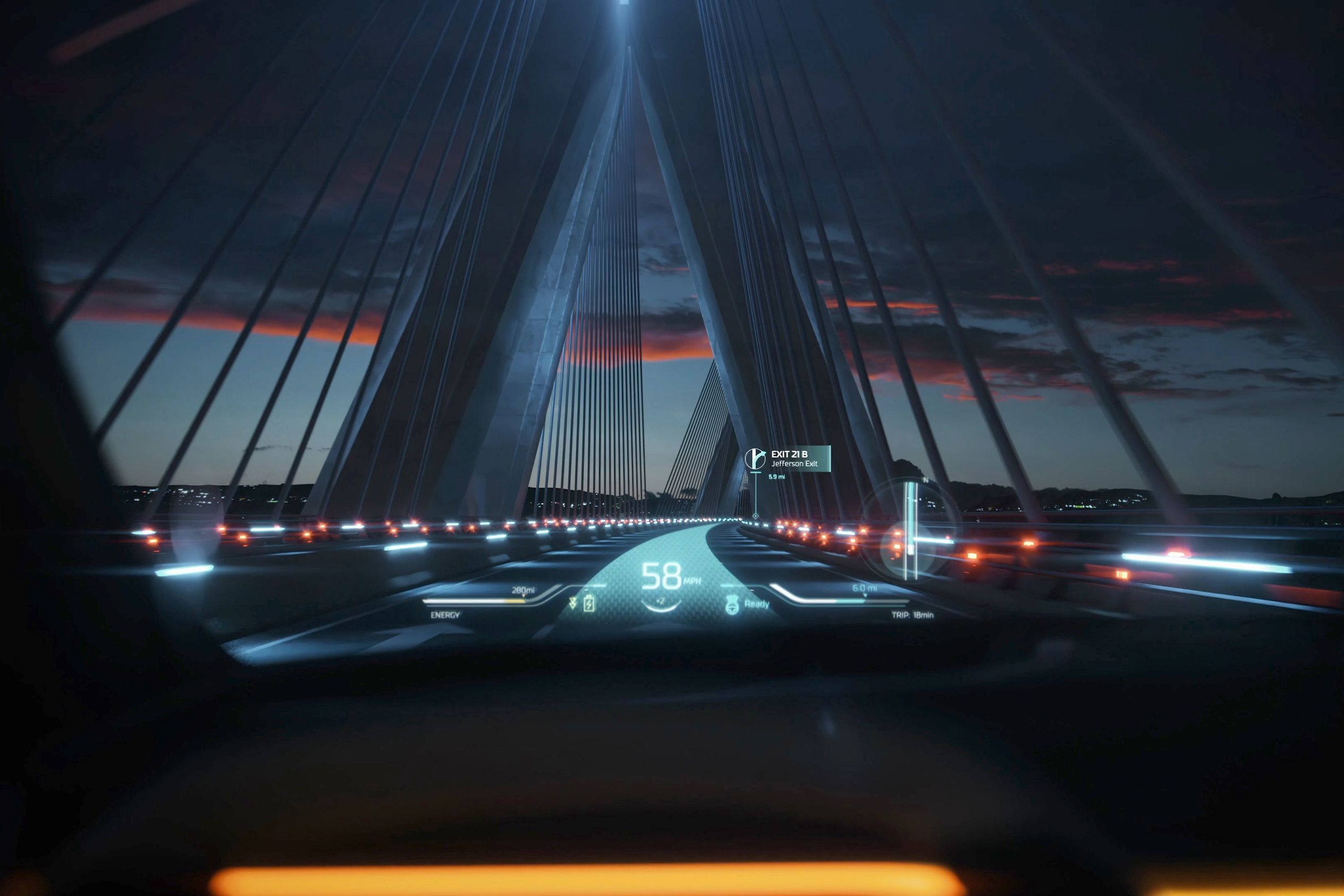- Ram 1500 Revolution BEV Concept previews production electric pickup truck for 2024
- Previews new Ram family face with "tuning fork" headlight design
- Powered midgate and frunk pass-through enable 18 feet of storage
- Third-row jump seats and fully configurable interior
- Twin-motor powertrain and 800-volt architecture that replenishes 100 miles range in 10 minutes
Ram has today unveiled the Ram 1500 Revolution BEV Concept at CES in Las Vegas as a precursor to the production Ram 1500 EV, expected to hit the streets in 2024 potentially called the Ram 1500 REV. Ram says it will set the new standard in parameters truck owners care about. These include range, towing, payload, and charge time.
Based on the STLA Frame architecture, this body-on-frame truck concept takes direct aim at the Ford F-150 Lightning and Chevrolet Silverado 1500 EV. But despite arriving later, Ram is adamant that this will make the truck no less effective, as it will not make the same mistakes as its rivals.
Ram CEO, Mike Koval, was open about the 1500 EV's development phase and how customers were involved. Speaking to Koval at CES 2023, he told CarBuzz that Ram engineers spoke to owners on the Ram Tour to find out exactly what they wanted from an electric pickup, stating that "we will not only meet but also exceed virtually all of [their demands]."
Back to the concept, though. The figures we're most interested in aren't available yet; Ram did not provide output figures nor claims about towing, hauling, or range. However, we do know a few of the technical details. The truck will have four-wheel steering with up to 15 degrees of articulation, and the standard air suspension will have three modes: ingress/egress, aero, and off-road. Note the lack of a silly "sport" mode.
We also know that it will have the segment-standard dual motor setup and an 800-volt architecture. Charging at rates of up to 350 kW, it can add 100 miles in approximately 10 minutes.
Koval provided CarBuzz with additional info, however. "Research has shown us people are open-minded to electrification but are not willing to compromise on core attributes," said Koval. "Range and charge time equals internal performance index, and [Ram] has taken this and adjusted it. Ram's suite of solutions will exceed competitors. Trucks still have to do truck things. Electrification cannot be a limitation."
Home charging is easier thanks to the Ram Charger, a new inductive robot charger. It detects the vehicle's presence and how much charge it needs and automatically aligns itself under the car. This little robot also knows to charge during an off-peak time, saving the owner a few bucks.
Given Koval's desire to be the best, we can only assume that the Ram EV will come with a larger battery pack than its main rivals. General Motors has gone for brute power with the 754-horsepower Silverado and Sierra EVs, and the same goes for Rivian. The Ford F-150 Lightning only produces 580 hp (when did that become low?), but we now know that its 131 kWh battery does not have enough juice for towing and hauling.
Ram describes the exterior of the Revolution as "brutiful," which is the marketing department smashing together the words brutal and beautiful. We maintain that beauty is in the eye of the beholder, so we'll leave it up to you to judge.
We do like the direction Ram is going in with the front end and grille, including animated "tuning fork" DRLs and an animated Ram logo, which, according to Koval, will make production. The rear lights and badge are also LED and fully animated.
Usually, suicide doors on a concept don't make it to production, but we wouldn't be surprised if they feature on the final product. Given the flexibility of the flat floor, Ram might push these doors to production to give customers easier access to the innovative interior.
As for the functional exterior features, the Revolution has many. Everything is powered, including the frunk, door handles, charging port, tailgate, side steps, and rear step.
As you can see, the wheel arches do not protrude into the Rambox. Speaking of, the fender wells can clear a 35-inch tire. The concept rides on a set of 24-inch wheels, and the center caps are illuminated and stay in place when the car is moving, Rolls-Royce style.
The truck rides on Stellantis' STLA Frame EV platform, giving the designers more freedom. The entire cabin was shifted forward so the length could be increased by four inches while the bed length remained the same as the standard ICE 1500.
Ram calls the interior a "one-space environment," and it basically just means the flat floor provides more interior layout flexibility than any truck we've ever seen. The Revolution is equipped with the Ram Track system, a rail attachment/floor track system. It allows the customer to add and remove seats and consoles. The lightweight seats come with integrated seatbelts, grab handles, and speakers, so there's nothing left on the inside to get in the way.
The interior also has tie-down hooks if an owner wants to use it as a work truck. Thanks to the rails, one can easily remove the back seats and use that space for precious cargo you don't want to leave in the load bin.
These rails are impressive but are not the Ram Revolution's party piece. It also has a powered mid-gate with mounted jump seats. Yup, the Revolution has three-row seating, but that's still not the best part.
An EV doesn't need a transmission or driveshaft tunnel, and Ram uses that space perfectly. With the midgate down and the connection between the interior and frunk open, you can load objects up to 18 feet long with the tailgate closed.
The tuning fork motif is carried through on the inside using ambient lighting. The touchscreen infotainment system is the most prominent feature, consisting of two screens offering 28 inches of space. Ram removed all physical buttons, which we don't like. Instead, the lower screen can be used in three modes: minimal, extended, and full-screen. We'll reserve comment until we've experienced it, but adding every feature (especially HVAC) to a single screen is always a miss and has proven to be distracting.
The lower screen is not physically attached to the upper screen. It can also be removed and mounted anywhere in the cabin via the rail system, so the rear kids can play games or watch movies using wireless controllers and headphones.
The screen provides a 360-degree view when reversing, using the various external cameras, and a floodlight will activate when the car is in reverse, providing additional visibility.
As is the norm these days, the Ram 1500 EV comes with an environmentally-friendly vegan interior that is animal and cruelty-free. Instead of peeling cows, Ram is peeling apples to make its vegan leather, which is a bi-product of the apple industry. The Greyslate Nanostone veneer used in this car is abundant, lightweight, and robust. The textured floor is made from recycled rubber and cork.
Because early adopters will likely purchase this car, Ram had to fill it up with a bunch of shock-and-awe features to lure people in. This truck is rated as Level 3+ autonomous, which means the steering wheel retracts, leaving more space for the driver. It also has an augmented reality head-up display, which lets the driver see through things using the various exterior cameras.
Naturally, there are obligatory exterior cameras that do all the usual stuff but can also identify a face. You can control a smart home directly from the infotainment screen, and the truck even has an exterior projector for movie nights. Ram also mentions an Intelligent Storage App, which you can use to obtain an object's dimensions by scanning a barcode or using the augmented reality measuring tool. The mobile app will then tell you whether the item will fit on the truck and what the best position for it would be.
It has the obligatory virtual assistant that responds to voice controls, but Ram took it a step further by also making it active in Shadow Mode. The latter is one of the best features we've ever heard of. The car will follow the owner around like a loyal dog, and you can give it instructions from the outside. It's like the Tesla Summon feature but dialed up to 11.
Also included are a day planner and various cabin modes depending on what the owner is doing that day. It can adjust interior lighting, seat position and orientation, window and skylight opacity, vehicle suspension, sound zones, and display content according to several preset modes, like Social, Party, Relax, or a user-created mode.
It's unclear whether all of the features will make it into the vehicle, but what is clear is that Ram was wise to wait. Reading through this article, you can see where Ram borrowed inspiration and where it improved on a concept.
The big question now, at least to customers who use their trucks to tow and haul, is whether Ram can deliver on the promises made by its CEO.


